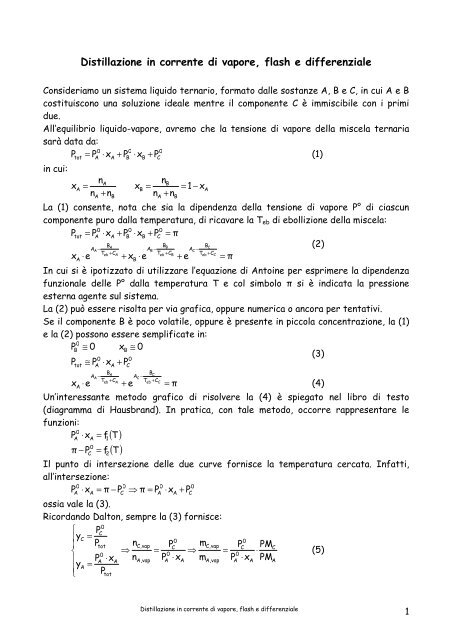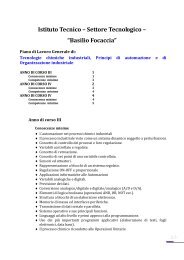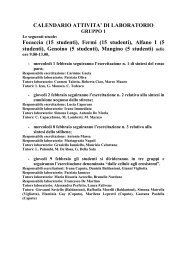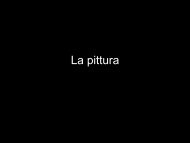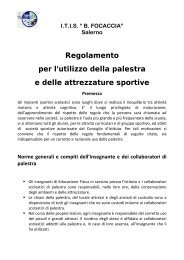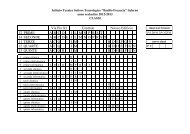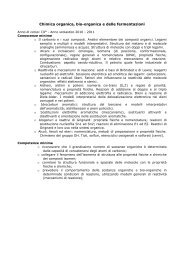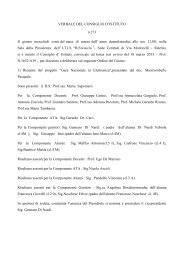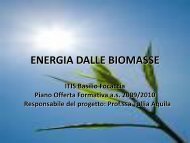Distillazione in corrente di vapore, flash e differenziale - Itisfocaccia.it
Distillazione in corrente di vapore, flash e differenziale - Itisfocaccia.it
Distillazione in corrente di vapore, flash e differenziale - Itisfocaccia.it
Create successful ePaper yourself
Turn your PDF publications into a flip-book with our unique Google optimized e-Paper software.
<strong>Distillazione</strong> <strong>in</strong> <strong>corrente</strong> <strong>di</strong> <strong>vapore</strong>, <strong>flash</strong> e <strong>di</strong>fferenziale<br />
Consideriamo un sistema liquido ternario, formato dalle sostanze A, B e C, <strong>in</strong> cui A e B<br />
cost<strong>it</strong>uiscono una soluzione ideale mentre il componente C è immiscibile con i primi<br />
due.<br />
All’equilibrio liquido-<strong>vapore</strong>, avremo che la tensione <strong>di</strong> <strong>vapore</strong> della miscela ternaria<br />
sarà data da:<br />
0<br />
0<br />
0<br />
P = P ⋅x<br />
+ P ⋅x<br />
+ P<br />
(1)<br />
<strong>in</strong> cui:<br />
x<br />
tot<br />
A<br />
A<br />
A<br />
A<br />
nA<br />
=<br />
n + n<br />
B<br />
B<br />
x<br />
B<br />
B<br />
C<br />
nB<br />
=<br />
n + n<br />
A<br />
B<br />
= 1 − x<br />
A<br />
La (1) consente, nota che sia la <strong>di</strong>pendenza della tensione <strong>di</strong> <strong>vapore</strong> P° <strong>di</strong> ciascun<br />
componente puro dalla temperatura, <strong>di</strong> ricavare la T eb <strong>di</strong> ebollizione della miscela:<br />
0<br />
0<br />
0<br />
Ptot<br />
= PA<br />
⋅xA<br />
+ PB<br />
⋅xB<br />
+ PC<br />
= π<br />
BA<br />
BB<br />
BC<br />
(2)<br />
AA<br />
−<br />
AB<br />
−<br />
AC<br />
−<br />
Teb<br />
+ CA<br />
Teb<br />
+ CB<br />
Teb<br />
+ CC<br />
x ⋅e<br />
+ x ⋅e<br />
+ e = π<br />
A<br />
B<br />
In cui si è ipotizzato <strong>di</strong> utilizzare l’equazione <strong>di</strong> Anto<strong>in</strong>e per esprimere la <strong>di</strong>pendenza<br />
funzionale delle P° dalla temperatura T e col simbolo π si è <strong>in</strong><strong>di</strong>cata la pressione<br />
esterna agente sul sistema.<br />
La (2) può essere risolta per via grafica, oppure numerica o ancora per tentativi.<br />
Se il componente B è poco volatile, oppure è presente <strong>in</strong> piccola concentrazione, la (1)<br />
e la (2) possono essere semplificate <strong>in</strong>:<br />
0<br />
PB<br />
≅ 0 xB<br />
≅ 0<br />
(3)<br />
0<br />
0<br />
P ≅ P ⋅x<br />
+ P<br />
tot A A C<br />
BA<br />
BC<br />
AA<br />
−<br />
AC<br />
−<br />
Teb<br />
+ CA<br />
Teb<br />
+ CC<br />
A<br />
⋅e<br />
+ e =<br />
x<br />
π<br />
Un’<strong>in</strong>teressante metodo grafico <strong>di</strong> risolvere la (4) è spiegato nel libro <strong>di</strong> testo<br />
(<strong>di</strong>agramma <strong>di</strong> Hausbrand). In pratica, con tale metodo, occorre rappresentare le<br />
funzioni:<br />
P<br />
0<br />
A<br />
⋅x<br />
π − P<br />
A<br />
0<br />
C<br />
= f<br />
= f<br />
( T)<br />
( T)<br />
1<br />
2<br />
Il punto <strong>di</strong> <strong>in</strong>tersezione delle due curve fornisce la temperatura cercata. Infatti,<br />
all’<strong>in</strong>tersezione:<br />
0<br />
0<br />
0<br />
0<br />
P ⋅ x = π − P ⇒ π = P ⋅x<br />
+ P<br />
A<br />
A<br />
C<br />
ossia vale la (3).<br />
Ricordando Dalton, sempre la (3) fornisce:<br />
0<br />
⎧ PC<br />
⎪yC<br />
=<br />
0<br />
Ptot<br />
nC,vap<br />
P m<br />
C<br />
C,vap<br />
⎨ ⇒ = ⇒ =<br />
0<br />
0<br />
⎪ P n<br />
A<br />
⋅xA<br />
A,vap<br />
PA<br />
⋅xA<br />
mA,vap<br />
yA<br />
=<br />
⎪<br />
⎩ Ptot<br />
A<br />
A<br />
C<br />
P<br />
P<br />
0<br />
C<br />
0<br />
A<br />
⋅xA<br />
PM<br />
⋅<br />
PM<br />
C<br />
A<br />
(4)<br />
(5)<br />
<strong>Distillazione</strong> <strong>in</strong> <strong>corrente</strong> <strong>di</strong> <strong>vapore</strong>, <strong>flash</strong> e <strong>di</strong>fferenziale<br />
1
In<strong>di</strong>cando con C l’acqua, la (5) permette <strong>di</strong> calcolare i kg <strong>di</strong> <strong>vapore</strong> da dover consumare<br />
per far evaporare 1 kg <strong>di</strong> sostanza A dalla miscela liquida <strong>in</strong>iziale. Come si nota questa<br />
quant<strong>it</strong>à è tanto maggiore quanto più <strong>di</strong>lu<strong>it</strong>a è la miscela rispetto ad A e quanto m<strong>in</strong>ore<br />
è il suo peso molecolare.<br />
800<br />
700<br />
P [mmHg]<br />
600<br />
500<br />
400<br />
300<br />
π-P C<br />
PA<br />
200<br />
100<br />
0<br />
50 60 70 80 90 100<br />
T [°C]<br />
T ebollizione<br />
Fig. 1 – Diagramma <strong>di</strong> Hausbrand<br />
La <strong>di</strong>stillazione <strong>in</strong> <strong>corrente</strong> <strong>di</strong> <strong>vapore</strong> è <strong>di</strong> norma utilizzata con miscele cost<strong>it</strong>u<strong>it</strong>e da<br />
sostanze, <strong>in</strong>solubili <strong>in</strong> acqua, aventi alto punto <strong>di</strong> ebollizione e il cui raggiungimento<br />
sarebbe troppo <strong>di</strong>spen<strong>di</strong>oso, oppure pericoloso, o ancora potrebbe determ<strong>in</strong>are la<br />
decomposizione della sostanza stessa.<br />
In presenza <strong>di</strong> acqua <strong>in</strong>fatti, il punto <strong>di</strong> ebollizione si abbassa (<strong>in</strong> misura anche<br />
notevole) per cui la separazione risulta più agevole.<br />
Questa tecnica <strong>di</strong> <strong>di</strong>stillazione può essere attuata sia <strong>in</strong> maniera <strong>di</strong>scont<strong>in</strong>ua che<br />
cont<strong>in</strong>ua. Nel primo caso l’apparecchio è cost<strong>it</strong>u<strong>it</strong>o da un semplice serbatoio<br />
<strong>in</strong>camiciato nel quale viene <strong>in</strong>trodotta la miscela da <strong>di</strong>stillare e nel quale viene fatto<br />
gorgogliare il vapor d’acqua. Nella camicia esterna viene fatto circolare vapor d’acqua<br />
<strong>di</strong> riscaldamento <strong>in</strong> quanto il calore <strong>di</strong> surriscaldamento ceduto dal <strong>vapore</strong> che<br />
gorgoglia nel liquido non è sufficiente a garantire l’ebollizione della miscela. I vapori<br />
uscenti dal serbatoio vengono qu<strong>in</strong><strong>di</strong> raffreddati e condensati ed <strong>in</strong>trodotti <strong>in</strong> un<br />
separatore-decantatore dal quale fuoriescono (a <strong>di</strong>fferenti altezze) l’acqua e il<br />
prodotto desiderato.<br />
Lo stesso apparecchio può essere utilizzato anche per l’operazione cont<strong>in</strong>ua anche se,<br />
<strong>in</strong> quest’ultimo caso, si preferisce l’uso <strong>di</strong> una colonna a piatti sprovvista <strong>di</strong> riboll<strong>it</strong>ore<br />
<strong>Distillazione</strong> <strong>in</strong> <strong>corrente</strong> <strong>di</strong> <strong>vapore</strong>, <strong>flash</strong> e <strong>di</strong>fferenziale<br />
2
<strong>di</strong> coda e dal fondo della quale viene <strong>in</strong>iettato <strong>di</strong>rettamente <strong>vapore</strong> <strong>di</strong> rete W. Il<br />
calcolo (secondo il metodo <strong>di</strong> McCabe-Thiele) è identico a quello <strong>di</strong> una colonna con<br />
riboll<strong>it</strong>ore. L’unica <strong>di</strong>fferenza nella procedura consiste nel tracciamento della retta <strong>di</strong><br />
lavoro <strong>in</strong>feriore.<br />
Fig. 2 – <strong>Distillazione</strong> <strong>in</strong> <strong>corrente</strong> <strong>di</strong> <strong>vapore</strong><br />
Per una colonna con riboll<strong>it</strong>ore abbiamo <strong>in</strong>fatti (dal bilancio <strong>di</strong> materia sul componente<br />
volatile A nella sezione <strong>di</strong> esaurimento):<br />
V'y ⋅ = L'x ⋅ −B⋅x<br />
B<br />
L' B<br />
y = ⋅x<br />
− ⋅xB<br />
V' V'<br />
E, ricordando che (dal bilancio <strong>di</strong> materia globale sulla sezione <strong>di</strong> esaurimento):<br />
L' = V' + B<br />
otteniamo che l’<strong>in</strong>tersezione della retta con la <strong>di</strong>agonale y = x avviene nel punto:<br />
L' B ⎛ L' ⎞ B<br />
x = ⋅x<br />
− ⋅xB<br />
⇒ x ⋅⎜<br />
−1⎟<br />
= ⋅xB<br />
⇒ x = xB<br />
V' V' ⎝ V' ⎠ V'<br />
Per una colonna senza riboll<strong>it</strong>ore <strong>di</strong> coda:<br />
V'y ⋅ = L'x ⋅ − L'x ⋅<br />
B<br />
L' L'<br />
y = ⋅x<br />
− ⋅xB<br />
V' V'<br />
Relazione da cui si ricava che l’<strong>in</strong>tersezione della retta <strong>di</strong> lavoro con l’asse delle<br />
ascisse y = 0 avviene nel punto:<br />
<strong>Distillazione</strong> <strong>in</strong> <strong>corrente</strong> <strong>di</strong> <strong>vapore</strong>, <strong>flash</strong> e <strong>di</strong>fferenziale<br />
3
L' L' L' L'<br />
0 = ⋅x<br />
− ⋅xB<br />
⇒ ⋅x<br />
= ⋅xB<br />
⇒ x = x<br />
V' V' V' V'<br />
B<br />
Fig. 3 – Metodo <strong>di</strong> McCabe-Thiele per colonna a piatti senza riboll<strong>it</strong>ore<br />
Un’altra tecnica <strong>di</strong> <strong>di</strong>stillazione è quella cosiddetta <strong>flash</strong> o <strong>di</strong> equilibrio.<br />
Fig. 4 – <strong>Distillazione</strong> Flash<br />
<strong>Distillazione</strong> <strong>in</strong> <strong>corrente</strong> <strong>di</strong> <strong>vapore</strong>, <strong>flash</strong> e <strong>di</strong>fferenziale<br />
4
In questa operazione la miscela liquida da separare viene riscaldata e vaporizzata <strong>in</strong><br />
parte. La vaporizzazione può essere facil<strong>it</strong>ata abbassando contemporaneamente la<br />
pressione del sistema. La <strong>corrente</strong> liquido-<strong>vapore</strong> viene qu<strong>in</strong><strong>di</strong> immessa <strong>in</strong> un<br />
separatore dal quale fuoriescono, <strong>in</strong> alto, i vapori che, condensati, andranno a<br />
cost<strong>it</strong>uire il <strong>di</strong>stillato, mentre dal fondo si ottiene la fase liquida cost<strong>it</strong>uente il<br />
prodotto <strong>di</strong> coda o residuo. E’ una operazione basata su un solo sta<strong>di</strong>o <strong>di</strong> equilibrio per<br />
cui il grado <strong>di</strong> separazione ottenibile sarà modesto.<br />
Le composizioni del <strong>di</strong>stillato e del prodotto <strong>di</strong> coda si possono ottenere dal bilancio <strong>di</strong><br />
materia (totale e parziale).<br />
Avremo <strong>in</strong>fatti:<br />
F = D + B<br />
F ⋅x<br />
F<br />
= D⋅x<br />
D<br />
+ B⋅x<br />
B<br />
Per cui, <strong>in</strong><strong>di</strong>cando con q la frazione dell’alimentazione F rimasta allo stato liquido dopo<br />
la vaporizzazione, e con y e x le composizioni del <strong>di</strong>stillato e del residuo:<br />
F = F ⋅ 1- q + F⋅q<br />
F⋅x<br />
F<br />
F⋅x<br />
F<br />
( )<br />
F ⋅( 1- q)<br />
=<br />
= F ⋅<br />
⋅x<br />
D<br />
+ F ⋅q⋅x<br />
B<br />
q<br />
q-1<br />
1<br />
q −1<br />
( 1- q) ⋅ y + F ⋅q⋅x<br />
⇒ y = ⋅x<br />
− ⋅xF<br />
che è l’equazione della retta “q”. Il punto <strong>di</strong> <strong>in</strong>tersezione <strong>di</strong> tale retta con la curva <strong>di</strong><br />
equilibrio del sistema, <strong>in</strong><strong>di</strong>vidua le composizioni y ed x cercate.<br />
Fig. 5 – Calcolo della composizione f<strong>in</strong>ale <strong>in</strong> un <strong>di</strong>stillatore Flash<br />
<strong>Distillazione</strong> <strong>in</strong> <strong>corrente</strong> <strong>di</strong> <strong>vapore</strong>, <strong>flash</strong> e <strong>di</strong>fferenziale<br />
5
E’ evidente che tale procedura <strong>di</strong> calcolo presuppone la conoscenza del valore <strong>di</strong> q.<br />
Nel caso <strong>in</strong> cui non si conosca il valore <strong>di</strong> q ma fossero <strong>in</strong>vece note temperatura T e<br />
pressione totale P f<strong>in</strong>ali del sistema, per ottenere composizioni e quant<strong>it</strong>à relative del<br />
<strong>di</strong>stillato e del residuo si dovrà fare ricorso alle note formule (leggi <strong>di</strong> Raoult, Dalton<br />
e regola della leva):<br />
0<br />
0<br />
P − PB<br />
PA<br />
⋅x<br />
x =<br />
y =<br />
0 0<br />
PA<br />
− PB<br />
P<br />
B D<br />
F = D + B ⇒ = 1 −<br />
F F<br />
F⋅x<br />
= D⋅<br />
y + B⋅x<br />
F⋅x<br />
F⋅<br />
F<br />
F<br />
= D⋅<br />
y +<br />
( F -D)<br />
⋅x<br />
( x − x) = D⋅( y -x)<br />
F<br />
⇒<br />
D<br />
F<br />
=<br />
( xF<br />
− x)<br />
( y - x)<br />
L’ultima tecnica <strong>di</strong> <strong>di</strong>stillazione che esam<strong>in</strong>eremo è quella così detta semplice, o<br />
<strong>di</strong>fferenziale, o batch. È la classica <strong>di</strong>stillazione <strong>di</strong>scont<strong>in</strong>ua da laboratorio che<br />
utilizza come strumento l’alambicco.<br />
Fig. 6 – Distillatore batch da laboratorio<br />
L’analisi teorica <strong>di</strong> questo tipo <strong>di</strong> operazione è alquanto complessa, dovendo fare<br />
ricorso ad equazioni <strong>di</strong>fferenziali (e non più algebriche) per descrivere l’evoluzione nel<br />
tempo del sistema che non è più <strong>in</strong> con<strong>di</strong>zioni stazionarie e nel quale si mo<strong>di</strong>ficano sia<br />
la composizione del <strong>di</strong>stillato che del residuo.<br />
Si scrivono i classici bilanci <strong>di</strong> materia globale e parziale (componente più volatile):<br />
F = D + B<br />
(6)<br />
F⋅x<br />
= D⋅<br />
y + B⋅x<br />
F<br />
me<strong>di</strong>o<br />
<strong>in</strong> cui questa volta F sono le moli <strong>in</strong>iziali sottoposte a <strong>di</strong>stillazione, D il <strong>di</strong>stillato<br />
raccolto f<strong>in</strong>o ad un certo istante t e B il liquido residuo allo stesso istante. Si noti<br />
come la composizione del <strong>di</strong>stillato che compare nel bilancio rappresenti il valore<br />
me<strong>di</strong>o relativo all’<strong>in</strong>tervallo <strong>di</strong> tempo t considerato. Infatti <strong>in</strong> ogni istante la<br />
<strong>Distillazione</strong> <strong>in</strong> <strong>corrente</strong> <strong>di</strong> <strong>vapore</strong>, <strong>flash</strong> e <strong>di</strong>fferenziale<br />
6
composizione y del <strong>vapore</strong> è quella che fa equilibrio alla composizione x del liquido<br />
nell’alambicco.<br />
Quelli su scr<strong>it</strong>ti rappresentano i bilanci <strong>di</strong> materia relativi ad un <strong>in</strong>tervallo <strong>di</strong> tempo t<br />
f<strong>in</strong><strong>it</strong>o. Volendo scrivere gli stessi bilanci per un <strong>in</strong>tervallo <strong>in</strong>f<strong>in</strong><strong>it</strong>esimo dt avremo,<br />
<strong>di</strong>fferenziando le medesime espressioni rispetto al tempo (si ricor<strong>di</strong> che F ed x F<br />
assumono valori costanti e non rappresentano variabili):<br />
dF = dD + dB = 0 ⇒ dD = −dB<br />
( ⋅x<br />
) = d( D⋅<br />
y ) + d( B⋅x) 0<br />
d F<br />
F me<strong>di</strong>o<br />
=<br />
E, <strong>in</strong> base alla def<strong>in</strong>izione <strong>di</strong> valore me<strong>di</strong>o <strong>di</strong> una funzione 1 :<br />
D<br />
∫<br />
y ⋅dD<br />
0<br />
yme<strong>di</strong>o<br />
= ⇒ d D<br />
D<br />
y ⋅dD<br />
= −dB⋅x<br />
−B⋅dx<br />
dB<br />
B<br />
=<br />
dx<br />
( y − x)<br />
( ⋅ y )<br />
me<strong>di</strong>o<br />
= y ⋅dD<br />
Integrando tra gli estremi F e B ed x F ed x:<br />
B<br />
∫<br />
F<br />
dB<br />
=<br />
B<br />
x<br />
∫ ( y − x )<br />
x<br />
F<br />
dx<br />
Quella ora scr<strong>it</strong>ta è l’equazione <strong>di</strong> Rayleigh che, <strong>in</strong>sieme alle (6), lega tra loro le 6<br />
variabili del processo: F, x F , D, y me<strong>di</strong>o , B, x. Fissate che siano 3 <strong>di</strong> tali variabili, le<br />
restanti possono essere calcolate dal sistema <strong>di</strong> equazioni così formato.<br />
Poiché però il sistema contiene una equazione <strong>in</strong> cui una delle possibili <strong>in</strong>cogn<strong>it</strong>e<br />
cost<strong>it</strong>uisce un estremo <strong>di</strong> <strong>in</strong>tegrazione, la soluzione non può avvenire per via <strong>di</strong>retta<br />
ma solo ricorrendo ad una procedura prova ed errore per tentativi (trial and error).<br />
Ad esempio, se si conoscono i valori della quant<strong>it</strong>à <strong>di</strong> prodotto da <strong>di</strong>stillare (F) e la sua<br />
composizione (x F ) nonché la concentrazione <strong>di</strong> <strong>di</strong>stillato che si desidera ottenere<br />
(y me<strong>di</strong>o ) il sistema, cost<strong>it</strong>u<strong>it</strong>o dalle (1) e dalla (3) fornisce:<br />
(7)<br />
1 Il valore me<strong>di</strong>o <strong>di</strong> una funzione y=f(x) è def<strong>in</strong><strong>it</strong>o dall’espressione:<br />
x+<br />
∆x<br />
∫<br />
x<br />
y ⋅dx<br />
y =<br />
∆x<br />
Nel caso <strong>in</strong> questione la variabile <strong>in</strong><strong>di</strong>pendente x è data dal volume <strong>di</strong> <strong>di</strong>stillato D, per cui:<br />
y =<br />
D<br />
∫<br />
0<br />
y ⋅dD<br />
≅<br />
D<br />
n<br />
∑<br />
i<br />
i=<br />
1<br />
n<br />
i=<br />
1<br />
y ⋅∆D<br />
∑<br />
∆D<br />
i<br />
i<br />
=<br />
n<br />
∑<br />
i=<br />
1<br />
y ⋅∆D<br />
i<br />
D<br />
i<br />
<strong>Distillazione</strong> <strong>in</strong> <strong>corrente</strong> <strong>di</strong> <strong>vapore</strong>, <strong>flash</strong> e <strong>di</strong>fferenziale<br />
7
xF<br />
⎧ dx<br />
⎪I<br />
=<br />
∫<br />
⎪ ( y − x)<br />
x<br />
⎧F<br />
= D + B<br />
⎪<br />
⎪<br />
F I<br />
⎪<br />
=<br />
⎪<br />
F⋅x<br />
= ⋅ + ⋅<br />
e<br />
F<br />
D yme<strong>di</strong>o<br />
B x ⎪B<br />
⎨<br />
⇒ ⎨D<br />
F<br />
= −1<br />
⎪ xF<br />
⎪B<br />
B<br />
⎪<br />
F dx<br />
ln =<br />
⎪<br />
⎪ ∫<br />
⎩<br />
B ( y − x)<br />
⎪<br />
F<br />
x<br />
⋅xF<br />
−1<br />
⎪<br />
y' =<br />
B<br />
⎪<br />
me<strong>di</strong>o<br />
D<br />
⎪<br />
⎩ B<br />
Vale a <strong>di</strong>re:<br />
1. si fissa un valore <strong>di</strong> tentativo per la composizione f<strong>in</strong>ale x del residuo<br />
2. si calcola per via anal<strong>it</strong>ica (se si conosce l’espressione della curva <strong>di</strong> equilibrio) o<br />
per via numerica (se la curva <strong>di</strong> equilibrio può essere calcolata solo per punti)<br />
l’<strong>in</strong>tegrale<br />
x F<br />
dx<br />
I =<br />
∫ −<br />
x<br />
( y x)<br />
3. si determ<strong>in</strong>a il valore assunto dalla composizione del <strong>di</strong>stillato y’ me<strong>di</strong>o<br />
4. se y’ me<strong>di</strong>o (calcolato) ≠ y me<strong>di</strong>o (dato del problema) si assume un nuovo valore <strong>di</strong><br />
tentativo per x e si riparte dal punto 1<br />
La procedura si basa qu<strong>in</strong><strong>di</strong> pr<strong>in</strong>cipalmente sul calcolo dell’<strong>in</strong>tegrale I. Tale calcolo,<br />
supponendo <strong>di</strong> utilizzare l’espressione della curva <strong>di</strong> equilibrio <strong>in</strong> funzione della<br />
volatil<strong>it</strong>à relativa α , porta a:<br />
α ⋅x<br />
y =<br />
1 + α −1<br />
⋅x<br />
I =<br />
xF<br />
∫<br />
( )<br />
dx<br />
=<br />
xF<br />
∫<br />
dx<br />
x<br />
( y − x)<br />
⎡ α ⋅ ⎤ ⎡α<br />
⋅x<br />
− x⋅( 1 + ( α −1)<br />
⋅x)<br />
x<br />
x<br />
⎢<br />
− x<br />
x<br />
( )<br />
⎥ ⎢<br />
⎣1<br />
+ α −1<br />
⋅x<br />
⎦ ⎣ 1 + ( α −1)<br />
⋅x<br />
xF x<br />
( ( ) )<br />
F<br />
1 1 1 x dx 1 A B<br />
I = + α − ⋅ ⋅<br />
⎡ ⎤<br />
⋅<br />
= ⋅<br />
dx<br />
( 1)<br />
x ( 1 x) ( 1) ∫ ⎢ +<br />
α − ∫ ⋅ − α − x ( 1 x)<br />
⎥ ⋅<br />
x<br />
x ⎣ − ⎦<br />
( 1 + ( α −1)<br />
⋅x)<br />
A B ⎧A<br />
= 1<br />
⎧A<br />
= 1<br />
= + ⇒ ⎨<br />
⇒ ⎨<br />
x ⋅( 1 − x) x ( 1 − x) − A + B = ( α −1)<br />
B = α<br />
I =<br />
1<br />
⎡<br />
⋅ ⎢<br />
⎢⎣<br />
xF<br />
∫<br />
dx<br />
+<br />
∫<br />
α ⋅dx<br />
⎤<br />
⎥ =<br />
⎥⎦<br />
( α −1) x ( 1 − x) ( α −1)<br />
x<br />
xF<br />
x<br />
⎩<br />
1<br />
=<br />
xF<br />
∫<br />
dx<br />
⎩<br />
⎛ xF<br />
1 − xF<br />
⋅⎜ln<br />
−α<br />
⋅ln<br />
⎝ x 1 − x<br />
⎞<br />
⎟<br />
⎠<br />
=<br />
⎤<br />
⎥<br />
⎦<br />
xF<br />
∫<br />
x<br />
( 1 + ( α −1)<br />
⋅x)<br />
⋅<br />
( α −1) ⋅x<br />
⋅( 1 − x)<br />
Un aspetto <strong>in</strong>teressante <strong>di</strong> questa tecnica si ha utilizzando non l’alambicco ma una<br />
colonna a piatti. In tal caso si riempie il riboll<strong>it</strong>ore e si parte fornendo calore al<br />
sistema. L’impianto si comporta come una colonna formata dal solo tronco <strong>di</strong><br />
arricchimento.<br />
dx<br />
<strong>Distillazione</strong> <strong>in</strong> <strong>corrente</strong> <strong>di</strong> <strong>vapore</strong>, <strong>flash</strong> e <strong>di</strong>fferenziale<br />
8
Fig. 7 – Distillatore batch a piatti<br />
L’operazione può essere condotta <strong>in</strong> due mo<strong>di</strong>:<br />
1. mantenendo costante il rapporto <strong>di</strong> riflusso. In tal caso le composizioni del<br />
<strong>di</strong>stillato e del residuo andranno via via <strong>di</strong>m<strong>in</strong>uendo nel corso del tempo;<br />
Fig. 8 – <strong>Distillazione</strong> batch a riflusso costante<br />
<strong>Distillazione</strong> <strong>in</strong> <strong>corrente</strong> <strong>di</strong> <strong>vapore</strong>, <strong>flash</strong> e <strong>di</strong>fferenziale<br />
9
2. aumentando il rapporto <strong>di</strong> riflusso dall’<strong>in</strong>izio alla f<strong>in</strong>e dell’operazione <strong>in</strong> maniera<br />
da mantenere costante la composizione del <strong>di</strong>stillato nel tempo. Il lim<strong>it</strong>e<br />
massimo <strong>di</strong> R sarà dato da R = ∞ s<strong>it</strong>uazione per la quale composizione del<br />
<strong>di</strong>stillato D e del residuo B saranno costanti nel tempo (non si immette né si<br />
toglie nulla dalla colonna)<br />
Fig. 9 – <strong>Distillazione</strong> batch a riflusso variabile<br />
Il calcolo <strong>di</strong> composizioni e portate viene effettuato utilizzando lo stesso sistema <strong>di</strong><br />
equazioni precedentemente <strong>in</strong>trodotto:<br />
⎧F<br />
= D + B<br />
⎪<br />
⎪<br />
F⋅xF<br />
= D⋅<br />
yme<strong>di</strong>o<br />
+ B⋅x<br />
⎨<br />
⎪ x F<br />
⎪<br />
F dx<br />
ln =<br />
⎪ ∫<br />
⎩<br />
B ( y − x)<br />
x<br />
solo che, questa volta il valore y (composizione del <strong>vapore</strong>) non è più quello ottenibile<br />
dalla curva <strong>di</strong> equilibrio <strong>in</strong> corrispondenza della composizione x del liquido nel<br />
riboll<strong>it</strong>ore, ma quello che deriva dalla costruzione a grad<strong>in</strong>i <strong>di</strong> McCabe-Thiele per il<br />
rapporto <strong>di</strong> riflusso scelto e per il numero <strong>di</strong> piatti esistente <strong>in</strong> colonna. Poiché tale<br />
valore deve essere ricavato per via grafica, il calcolo dell’<strong>in</strong>tegrale va effettuato per<br />
via numerica, una volta def<strong>in</strong><strong>it</strong>e un certo numero <strong>di</strong> coppie <strong>di</strong> valori (x, y).<br />
<strong>Distillazione</strong> <strong>in</strong> <strong>corrente</strong> <strong>di</strong> <strong>vapore</strong>, <strong>flash</strong> e <strong>di</strong>fferenziale<br />
10


